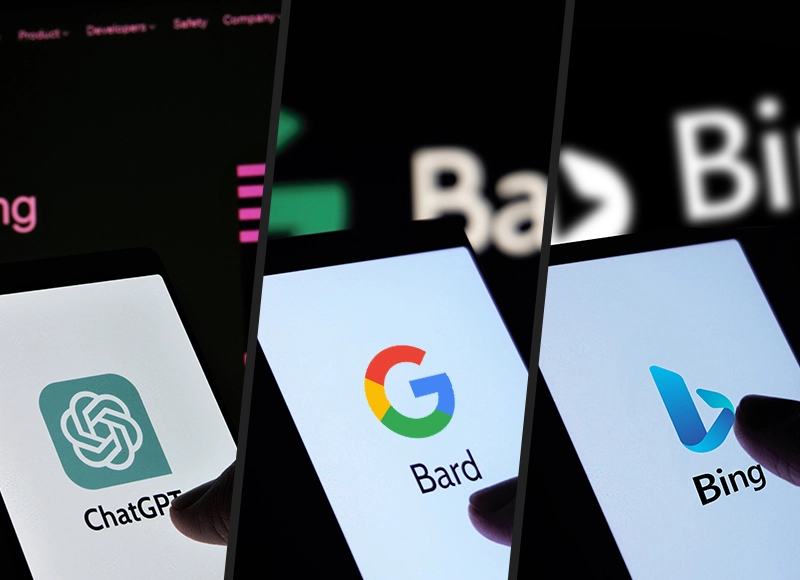Table of Contents
Discover the differences between ChatGPT, Bard, and Bing in this comprehensive comparative analysis. Find out which AI platform reigns supreme in the ultimate AI showdown!

A trinity of exceptional language models has emerged, wielding transformative power across industries and redefining user experiences.
Equip yourself for an in-depth exploration of the AI revolution as we dig into the details of Chat GPT, Bing AI, and Bard, from their intriguing impact on diverse sectors to the ethical considerations they command.
Learn through groundbreaking research and development, gazing into the crystal ball to glimpse the potential advancements and future implications that await businesses and society.
ChatGPT
ChatGPT is powered by GPT-3.5, which has 175 billion parameters and was trained on 45 terabytes of text data. ChatGPT can generate up to 2048 tokens of text per query. ChatGPT has over 100 million users as of July 2023.
ChatGPT stands as a groundbreaking advancement in the field of Conversational AI, offering an extraordinary level of interactive and engaging experiences.
Developed by OpenAI, ChatGPT combines state-of-the-art language modeling techniques with a deep understanding of context to provide users with a seamless and intuitive conversational interface.
History and Development of ChatGPT
The history of ChatGPT traces back to the pioneering research and development efforts of OpenAI. Building upon the success of previous language models, such as GPT-3, ChatGPT was trained on a colossal dataset, confining a wide range of internet text.
Using deep learning algorithms and vast computational resources, ChatGPT underwent rigorous training, allowing it to grasp complex language structures and generate coherent responses.
Features and Capabilities of ChatGPT
ChatGPT boasts remarkable features and capabilities that set it apart from its predecessors. Its natural language processing abilities enable it to comprehend user input, identify relevant information, and provide insightful responses. The model's contextual understanding allows for more fluid and dynamic conversations, making interactions with ChatGPT feel remarkably human-like.
With its sophisticated conversational AI, ChatGPT can assist users in various domains. It can answer questions, offer recommendations, engage in small talk, and even provide creative writing suggestions. Its versatility and adaptability make it a powerful tool for developers, content creators, and individuals seeking interactive conversational experiences.
Use Cases and Applications of ChatGPT
ChatGPT finds application across diverse sectors, showcasing its unique potential. In customer service, it can provide round-the-clock assistance, answering common queries and offering personalized solutions.
It can facilitate interactive learning experiences in educational settings, forging conversations with historical figures or explaining complex concepts. ChatGPT can also enhance content creation by generating ideas, improving writing fluency, and providing editorial support.
Strengths and Limitations of ChatGPT
ChatGPT exhibits many strengths, including its ability to engage users effectively, provide relevant information, and adapt to various conversational contexts. Its vast knowledge base allows it to draw from various topics, ensuring comprehensive responses.
However, it does have limitations. ChatGPT may sometimes generate incorrect or biased answers due to biases in the training data. Additionally, it may need help with ambiguous or ill-formed queries, requiring users to refine their inputs for optimal results.
User Experiences and Feedback of ChatGPT
Users have lauded ChatGPT for its exceptional conversational abilities, expressing admiration for its accurate and contextually appropriate responses. Many have found value in its vast knowledge base and the ease with which it assists in various tasks.
Nevertheless, some users have encountered occasional inaccuracies or instances where ChatGPT could be more concise or focused in its answers. OpenAI actively encourages user feedback to refine and improve the system continually.
Recent Updates and Advancements of ChatGPT
OpenAI remains committed to enhancing the capabilities of ChatGPT through continuous updates and advancements. Regular improvements in training methods and fine-tuning techniques aim to address its limitations while expanding its understanding of complex and nuanced language structures.
Additionally, OpenAI actively addresses concerns about bias and strives to make the system more transparent, accountable, and customizable for individual needs.
ChatGPT represents a pioneering leap forward in Conversational AI, providing an exceptional conversational experience through its advanced language modeling techniques and contextual understanding. With its wide-ranging applications, strengths, and ongoing advancements, ChatGPT continues to shape AI-driven interactions. As OpenAI evolves this impressive technology, the future promises even more captivating, engaging, and informative conversations for users worldwide.
Bard
Bard is powered by PaLM 2, the first PaLM was notable for its massive size: 540 billion parameters. Bard can generate up to 1024 tokens of text per query. Google’s Bard chatbot attracted 142.6 million visitors in May, up from 49.7 million [187.2%] in April.
With its unique features, versatile functionalities, and seamless integration, Bard is a true gem for wordsmiths and storytellers. This section will look into the fascinating world of Bard, exploring its potential applications, the invaluable feedback it has received, and its notable contributions and advancements.
Bard is more than just a writing tool; it is a muse that breathes life into words. Its intuitive interface provides a canvas upon which ideas flourish effortlessly. The user-friendly design ensures a seamless writing experience, allowing writers to focus solely on the creative process.
By eliminating distractions, Bard entrusts writers to tell their tales, unearthing stories that were once hidden in the depths of their imagination.
Unique features and functionalities of Bard
One of Bard's standout features is its powerful collaboration capabilities. Whether it's a team of writers working on a novel or colleagues collaborating on a business proposal, Bard fosters an environment where creativity thrives.
With real-time editing and seamless file sharing, Bard facilitates the collaborative process, making bringing collective ideas to life easier than ever.
Use cases and potential applications of Bard
The potential applications of Bard are boundless. From crafting compelling marketing copy to penning thought-provoking articles, Bard adapts effortlessly to various writing genres. Its versatility extends beyond traditional writing too.
Many have discovered that Bard serves as an invaluable tool for drafting speeches, creating engaging social media content, and even scripting dialogue for films and theater productions. Whatever the medium, Bard elevates the written word, transforming ideas into captivating narratives.
Feedback and reviews of Bard
The feedback from Bard users has been nothing short of exceptional. Writers from all walks of life have praised Bard's ability to kindle their creative sparks. They marvel at how Bard's seamless interface allows ideas to flow effortlessly, unburdened by technical complexities.
Users commend its intuitive features, such as the ability to easily organize and structure content, enabling them to stay focused and write with precision. Bard has become a trusted companion, inspiring writers to push the boundaries of their creativity.
Reviews have poured in, highlighting Bard's effectiveness as a writing tool. Writers laud its ability to assist in brainstorming, offering suggestions and alternative phrasing that enriches their work. The AI-powered language model that underpins Bard is visionary, continually learning and improving to provide an even more personalized writing experience.
Bard's users have marveled at how it understands their unique writing style, adapting to their preferences and helping them craft authentic and impactful content.
Notable contributions and advancements of Bard
Bard's notable contributions and advancements have solidified its position as a leader in the field. Its AI-driven algorithms constantly evolve, comprising the latest linguistic and storytelling advances.
The continuous updates ensure that Bard remains at the forefront of creative writing technology. Through ongoing research and development, Bard's creators are committed to expanding their capabilities, opening new opportunities for writers worldwide.
Bing AI
Bing AI is powered by DALL-E, which has 135 billion parameters and was trained on 250 gigabytes of text and image data. Bing AI can generate up to 256 tokens of text and up to 64x64 pixels of image per query. Bing now gets more than 100 million daily active users each day.
Search engines have become indispensable tools for finding information in the digital age. Bing, Microsoft's search engine, has adopted the power of Artificial Intelligence (AI) to provide users with a more intuitive and personalized search experience.
By integrating AI, Bing has transformed into a dynamic platform that delivers accurate results, enhances user interactions, and offers many features to make searching more efficient and enjoyable.
Integration of AI in Bing search engine of Bing AI
Bing's integration of AI has ushered in a new era of search engine capabilities. The marriage of advanced algorithms and machine learning has enabled Bing to understand user intent better and provide more relevant search results.
By analyzing vast amounts of data, including user behaviour, search patterns, and content analysis, Bing AI has evolved to deliver faster, more accurate, and tailored search results.
AI-powered features and enhancements of Bing AI
Bing AI brings innovative features that make the search experience seamless and intuitive. One such feature is intelligent answers, which provide concise information directly within the search results, saving users valuable time. Additionally, AI-driven image search allows users to discover visually similar images and explore related content effortlessly.
Bing's AI-powered natural language processing capabilities enable users to ask questions conversationally, receiving contextual and accurate answers. With personalized recommendations, Bing tailors search suggestions based on individual preferences, enhancing the user's journey through the web.
The AI-powered search experience is further enriched by intelligent video previews, which provide a glimpse of video content without leaving the search results page.
User experiences and benefits of Bing AI
Bing AI has significantly improved user experiences by offering a more refined and personalized search environment. Users can now access information quickly, with search results that match their preferences and interests. The intelligent features reduce the time spent filtering through irrelevant results, allowing users to find what they need efficiently.
Moreover, Bing AI's natural language understanding fosters a more conversational and interactive search experience. By interpreting context and intent, Bing AI ensures that users receive accurate and relevant answers to their queries. This personalized approach helps users find the information they seek faster and more effectively.
Challenges and improvements of Bing AI
While Bing AI has made impressive strides in search technology, there are ongoing challenges and opportunities for improvement. One challenge lies in continuously refining the algorithms to stay ahead of evolving user expectations and ever-changing web content. Bing is investing in cutting-edge research to enhance natural language understanding and improve the accuracy and relevance of search results.
Another key area of improvement is expanding AI-powered features to cater to a broader range of user needs and preferences. Bing aims to provide an inclusive search experience accommodating various languages, cultures, and regions.
With its integration of AI, Bing has transformed into a search engine that goes beyond simple keyword matching. The advanced capabilities offered by Bing AI have revolutionized the search experience, enabling users to find relevant information quickly and effortlessly.
From intelligent answers to personalized recommendations, Bing AI has reshaped how we search the web. As Bing continues to invest in AI research and development, we can expect even more innovative features and improvements that will further enhance the search experience for users worldwide.
Comparison of ChatGPT, Bard, and Bing AI
Artificial intelligence (AI) has emerged as a powerful tool for enhancing human experiences in today's rapidly evolving technological landscape. Among the remarkable AI models available, three prominent ones stand out: ChatGPT, Bard, and Bing AI.

In this comprehensive analysis, we will look into their language generation capabilities, use cases, training data, model architectures, user interfaces, scalability, limitations, and potential areas for future development.
Language Generation Capabilities and Performance
ChatGPT, Bard, and Bing AI possess extraordinary language generation capabilities, leveraging deep neural networks to generate coherent and contextually relevant responses.
These models excel in various language tasks, such as answering questions, providing recommendations, engaging in conversational dialogue, and even creative storytelling. Their performance is proof of the cutting-edge algorithms and immense training datasets, allowing them to produce high-quality outputs rival human-level fluency and understanding.
Use Cases and Suitability for Different Applications
Each AI model brings unique strengths, making them suitable for distinct applications. ChatGPT is renowned for its versatility, making it an excellent choice for customer support, content generation, and personal assistance.
On the other hand, Bard specializes in creative writing, collaborating with human authors to craft captivating narratives and poetry. Bing AI primarily powers search engines, enabling accurate and efficient information retrieval across various topics.
Training Data, Model Architecture, and Underlying Technology
The training data and model architecture greatly influence the performance and capabilities of AI systems. ChatGPT, developed by OpenAI, has been trained on a colossal corpus of internet text, providing a deep understanding of diverse language patterns and contexts.
Bard, a collaboration between OpenAI and professional authors, benefits from training with a mixture of human-crafted stories and online content. Bing AI leverages Microsoft's vast search engine data, ensuring comprehensive coverage and relevance in search results.
These models utilize state-of-the-art transformer architectures, such as GPT-3, to process and generate language-based outputs.
Differences in User Interfaces and Interaction Experiences
Regarding user interfaces, ChatGPT offers an interactive and conversational experience, enabling users to engage in dynamic and informative dialogues.
Bard, designed for creative collaborations, provides a more guided and collaborative interface, fostering a harmonious partnership between humans and AI.
Bing AI, as a search engine, offers a familiar and straightforward user interface, entrusting users to access the desired information effortlessly.
Scalability, Deployment, and Integration Options
Scalability plays a pivotal role in determining the real-world impact of AI models. ChatGPT, Bard, and Bing AI have all demonstrated their ability to scale, accommodating millions of simultaneous users.
These models can be deployed through API integrations, allowing seamless integration into various applications, platforms, and devices. With flexible deployment options, developers can utilize the power of AI and tailor it to meet their specific requirements.
Limitations and Areas for Further Development
Despite their remarkable achievements, these AI models do have limitations. They can sometimes produce inaccurate or biased information, reflecting the biases present in their training data. Handling sensitive topics and providing ethical guidance remain challenges.
Enhancing the controllability and explainability of AI systems is an ongoing focus, enabling users to fine-tune outputs while maintaining a transparent decision-making process. Further work is needed to ensure inclusivity, diverse representation, and improved context understanding.
ChatGPT, Bard, and Bing AI are extraordinary AI models with unique strengths and applications. Their language generation capabilities, training data, architectures, user interfaces, scalability, and integration options make them indispensable tools in various domains.
However, it is crucial to remain cognizant of their limitations and actively invest in their continuous development to shape a future where AI truly enhances our lives.
Current Trends and Future Outlook
Artificial intelligence (AI) has become a powerful force driving innovation across various industries. One of the most groundbreaking applications of AI is in the field of language models, which have witnessed a meteoric rise in recent years.
This report explores the impact of AI language models on different industries, the ethical considerations surrounding their usage, ongoing research and development efforts, potential advancements, and the implications for businesses, society, and user experiences.
Impact of AI-Language Models on Various Industries
AI language models have reformed the healthcare, finance, customer service, and content creation industries. In healthcare, AI models assist in analyzing vast amounts of medical data, enabling faster and more accurate diagnoses.
These models offer insights for investment decisions and risk analysis in the finance sector. Customer service has been enhanced through chatbots, which provide personalized and efficient responses to user queries. Content creation has also been transformed, with AI models generating high-quality written material, saving time and resources.
Ethical Considerations and Responsible AI Usage
As AI language models become increasingly sophisticated, addressing ethical considerations and ensuring responsible usage is essential. The potential for bias and discrimination in AI algorithms requires careful monitoring and mitigation. Transparency in how AI models make decisions is crucial to avoid unintended consequences.
Additionally, privacy concerns regarding user data must be addressed ensuring compliance with regulations and maintaining user trust. We can harness its potential by integrating ethical frameworks into AI development company while minimizing negative impacts.
Research and Development in AI-Language Models
The field of AI language models is evolving rapidly, with extensive research and development efforts underway. Researchers continuously refine models, optimize their performance, and explore new applications. Language models like OpenAI's GPT-3.5 push natural language understanding and generation boundaries.
Ongoing research focuses on reducing biases, improving interpretability, and enhancing user control. Collaborative efforts between academia, industry, and policymakers foster innovation and responsible AI development.
Potential Advancements and Future Directions
Looking ahead, the future of AI language models holds immense promise. Advancements in machine learning algorithms, computational power, and data availability will propel these models to new extremes. More refined contextual understanding, better language generation, and enhanced user interaction are anticipated.
AI language models may seamlessly integrate into daily life, facilitating communication, aiding decision-making, and extending human capabilities. Exciting possibilities emerge in fields like education, virtual assistants, and creative content generation.
Implications for Business, Society, and User Experiences
The impact of AI language models extends beyond individual industries. Businesses can leverage these models to simplify operations, improve customer experiences, and gain a competitive edge. Enhanced automation and intelligent decision-making foster efficiency and innovation. Societal implications include job transformations, necessitating reskilling and adaptation to a changing workforce.
User experiences are set to become more personalized and intuitive, with AI models understanding context, preferences, and intentions, resulting in improved user satisfaction and engagement.
AI language models have become a driving force in the technological landscape, with transformative impacts on various industries. Their potential to improve efficiency, enable better decision-making, and revolutionize user experiences is vast. However, responsible AI usage and ethical considerations are critical to ensure equitable and unbiased outcomes.
Continued research and development efforts will fuel advancements in the field, paving the way for a future where AI language models smoothly integrate into our daily lives, benefiting businesses, society, and users alike.
Conclusion
As we conclude our compelling journey through the AI showdown, where Chat GPT, Bing AI, and Bard battled for superiority, we can't help but be intrigued by the wonders of artificial intelligence. These extraordinary language models have altered industries, raised user experiences, and torched our collective imagination.
But this is just the beginning. The AI landscape continues to evolve, promising even greater advancements and possibilities. Together, let's venture on this exhilarating AI adventure, where knowledge meets innovation and where you'll find yourself returning for more fascinating insights into the exciting world of AI.









